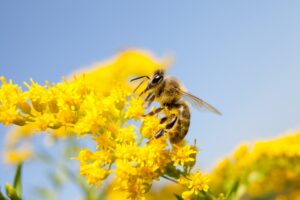
Happy Earth Day! What started in 1970 as a national event attended by 20 million Americans (10% of the U.S. population at the time) has blossomed into a global movement celebrated by over a billion people in over 184 countries. In its 50+ years, Earth Day has taken on many of the environment’s biggest issues – oil spills, air and water pollution, global warming, and even clean energy. It has even led to the creation of the Environmental Protection Agency (EPA) and the passage of such monumental legislation as the Clean Air, Clean Water, National Environmental Education, Occupational Safety & Health, and Endangered Species Acts, while internationally paving the way to the UN Earth Summit and the 2015 Paris Agreement. As we continue to fight for our planet against what ails her, it is important to remember that we are not alone in our contributions to preserving the health of our world.
If you’ve hung out with us for any length of time, you will know about the essential role that honey bees – and all our other pollinator friends – play in global food supply, but this pollination work does so much more than just put delicious foods on our tables. In fact, the plants that our bees, birds, bats, butterflies, beetles, etc., pollinate help to sustain ecosystems that keep our world in motion. According to the USDA’s National Resources Conservation Service (NRCS), “Plants are common ingredients in many NRCS conservation practices. That’s because they hold soil in place, protect stream banks and shores, filter pollutants, offer food for livestock and cover for wildlife. They also heal the land after wildfire, floods and drought.”1 Let’s dig in a little more.
Soil Health
According to the folks at the Heifer Ranch Center for Regenerative Agriculture, “[w]hen bees visit flowers, they spread pollen and nectar, which can help improve soil microbial activity and nutrient cycling. This helps to make the soil healthier and more fertile.”2
But more than this, the roots of the plants that honey bees pollinate help to hold soil together, preventing erosion, which the World Wildlife Fund (WWF) claims has “led to increased pollution and sedimentation in streams and rivers, clogging these waterways and causing declines in fish and other species. And degraded lands are also often less able to hold onto water, which can worsen flooding.”3
Seed Creation
Through their pollination efforts, honey bees help many plants produce seeds for cultivation. It is also said that due to their cross-pollination, “bees can create hybrids that may have better resistance to pests, diseases, and other environmental stressors, leading to more sustainable and regenerative farming practices, as well as better food security.”2
Clean Air & Water
We all learned about the air-cleaning power of trees in school, but there are a variety of plants that clean the air and water. World Wildlife Fund uses grasslands as an example in their article Why bees are climate heroes, explaining that
“A grassland is one type of ecosystem where bees play multiple important roles. These often-overlooked habitats are composed not just of grasses but of a broad community of wildflower species and flowering shrubs. Without the help of these fastidious creatures, flowering plants would no longer be able to reproduce at the same rate, eventually dying out, and we’d lose these species-rich and diverse ecosystems. This would be a big problem for our planet because unlike the grasses that grow in your local park, or shallow-rooted crops like corn and wheat, native grasslands plants often have very deep roots that reach 15 feet or more into the soil. While a forest stores the bulk of its carbon above ground in a tree’s trunks and branches, most grassland carbon is safely held below ground within these roots. Unlike forests, which lose most of their carbon once their trunks have burned, the carbon within a healthy grassland remains beyond the reach of fire, providing a second line of defense against a changing climate.”4
In addition to helping prevent soil from eroding into our water supply (as discussed above), honey bees also help to pollinate plants that filter and clean water.
Ecosystem Support
Perhaps one of the most important contributions our pollinators make through their work is the conservation of habitat for other wildlife. From pollinating feed for cattle and other larger animals to providing homes and protection for smaller critters, our bees keep delicate ecosystems intact.
But, of course, this all comes full circle. The contributions that honey bees make to our planet benefit them in return with bountiful healthy sources of pollen and nectar that help honey bees thrive and continue doing their life-sustaining work. If you would like to join the mission and help the bees – and all pollinators in your neighborhood – check out our Help The Bees page which is full of easy steps you can take to support pollinators in your area, including planting your very own garden made just for them.
This Earth Day, be sure to take a moment to celebrate the honey bees who bring our planet full circle.
SOURCES:
1 Natural Resources Conservation Service. (2024, April 3). Natural Resources Conservation Service. https://www.nrcs.usda.gov/conservation-basics/natural-resource-concerns/plants
2 Smith, J. (2023b, May 18). A sweet partnership: the relationship between bees and regenerative agriculture at Heifer Ranch. Heifer International. https://www.heifer.org/blog/relationship-between-bees-and-regenerative-agriculture-at-heifer-ranch.html
3 What is Erosion? Effects of Soil Erosion and Land Degradation. (n.d.). World Wildlife Fund. https://www.worldwildlife.org/threats/soil-erosion-and-degradation
4 Why bees are climate heroes | Stories | WWF. (n.d.). World Wildlife Fund. https://www.worldwildlife.org/stories/why-bees-are-climate-heroes
